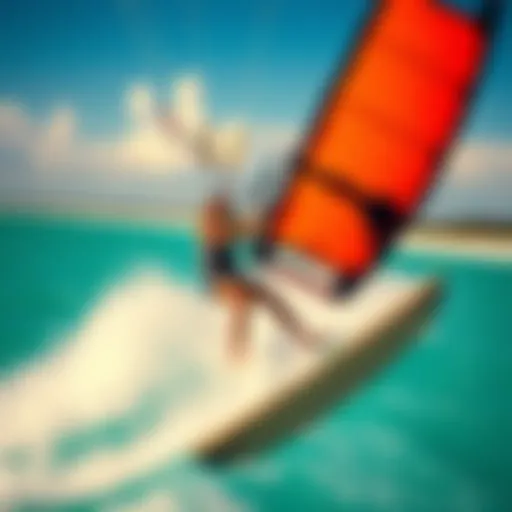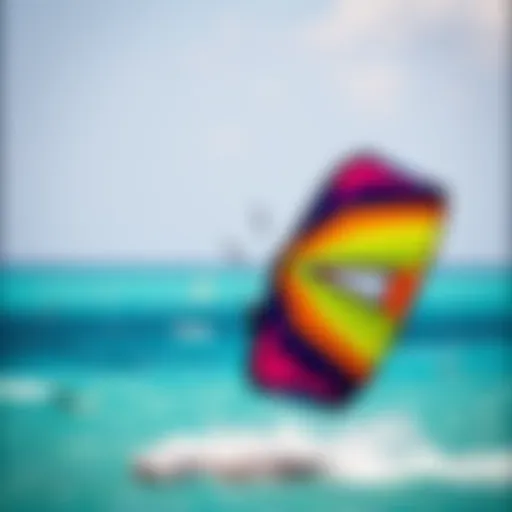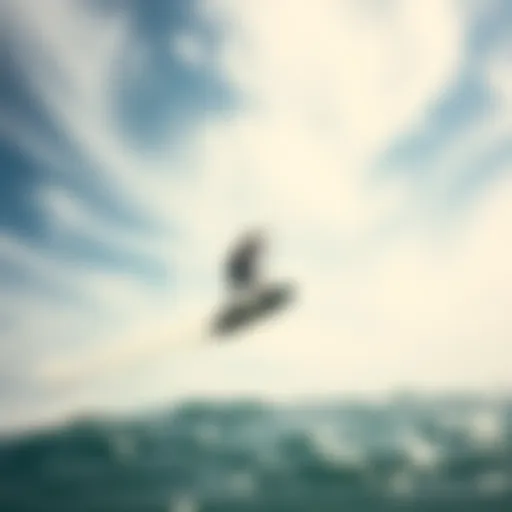The Essential Guide to Kite Anchors in Kiteboarding


Intro
Kiteboarding, often recognized for its exhilaration and adrenaline-inducing prowess, extends beyond the mere act of gliding over water with a kite in tow. At the heart of a truly immersive experience lies a critical yet often underestimated component: kite anchors. These tools, pivotal in their function, not only enhance rider safety but also amplify performance across varying conditions.
Understanding kite anchors is akin to grasping the very fabric of kiteboarding. Each session on the water can be influenced by numerous elements—from gusty winds teasing the kite’s stability to the unpredictable nature of water currents. A kite anchor stabilizes these experiences, acting as a reliable point of reference. Through this exploration, we aim to shed light on the significance of kite anchors, dissect the different types available, and offer practical insights maximizing their utility on your next adventure.
With the right anchor, even the roughest waters can become a playground, making kiteboarding not only enjoyable but also safer for everyone involved. Let’s dive deeper into the nuances of gear that surrounds this essential aspect of kiteboarding.
Understanding Kite Anchors
Kite anchors may not be the first piece of equipment that comes to mind when one thinks of kiteboarding; however, their significance cannot be overstated. They serve as the unsung heroes of the sport, acting as a lifeline to both performance and safety. Understanding kite anchors entails looking into their various functions, how they contribute to stability in changing conditions, and their role in reducing risks of accidents while enjoying the thrill of the wind and waves.
Why Consider Kite Anchors?
Every kiteboarder knows the rush of gliding over the water, but what happens when conditions get unpredictable? A robust kite anchor can mean the difference between a smooth ride and a harrowing experience. Anchors not only keep kites stationary when not in use but also adapt to differing wind strengths and directions, thus enhancing a rider's overall control.
In addition to providing stability, kite anchors can also help in managing equipment better, sparing kiteboards from getting tossed around by unrelenting gusts. All in all, comprehensively understanding kite anchors is essential for adventurers looking to bolster their kiteboarding sessions both in performance and tranquility.
Definition of a Kite Anchor
Kite anchors are specialized devices used to secure kites on the ground, ensuring that they don’t lift off prematurely or become damaged by errant winds. Under normal circumstances, these anchors come in various designs, tailored to suit different terrains and conditions. Think of a kite anchor as an insurance policy, providing that extra layer of protection when conditions are anything but favorable.
Essentially, the kite anchor functions by embedding itself into the ground—whether it be sand, grass, or other surfaces—creating a reliable hold that the kite can’t easily break away from. This is particularly critical in high winds and unpredictable weather, where losing control of a kite can lead not just to potential loss of equipment but also to safety concerns.
Historical Context and Development
Diving into the history of kite anchors reveals an evolution shaped by necessity and innovation. Initially, kiteboarding relied on rudimentary methods for securing kites, often leading users to rig their own makeshift anchors. Early kiteboarders might've resorted to surrounding heavier objects like backpacks or equipment to hold their kites down, a less-than-ideal strategy that often left much to be desired.
As the sport gained traction in the late '90s and early 2000s, the demand for more effective anchoring solutions became apparent. This led to advancements in design and material, making anchors that were more dependable and easier to use. Today, with a variety of options available ranging from screw-in anchors to specialized sandbags, kite anchors have undergone a revolution, echoing the sport's own journey from niche pastime to mainstream adventure.
"A good anchor doesn’t just secure a kite—it secures your peace of mind on the water."
With ongoing innovations in kiteboarding technology, we can expect kite anchors to continue evolving, ideally harmonizing with the kite’s design and enhancing the overall kiteboarding experience.
Types of Kite Anchors
Understanding the various types of kite anchors is paramount to enhancing safety and performance in kiteboarding. Choosing the right anchor not only helps in stabilizing the kite but can also significantly impact your overall experience on the water. As conditions change, knowing the specific attributes and applications of different anchors allows kiteboarders to make informed decisions, whether they are out for a leisurely ride or pushing their limits in challenging winds.
Traditional Anchors
Traditional anchors are the backbone of kite anchoring practices, having withstood the test of time for their simplicity and reliability. Typically made from heavy materials like iron or steel, these anchors can be easily placed in the sand or soft ground. The weight of a traditional anchor helps to hold the kite steady against strong winds.
However, it’s important to note that while these anchors are effective in many conditions, they may not always adhere well to rocky or uneven terrains. Pilots should ensure they place them properly and secure them as needed. It's a classic use that many kiteboarders rely on, which brings stability but also requires some knowledge of local terrain challenges to avoid mishaps.
Screw-in Anchors
Screw-in anchors are a game-changer for many kiteboarders, particularly in sandy environments. These anchors have a twisted design that allows them to be driven deep into the ground, providing a stronghold even when wind speeds start kicking up. The beauty of screw-in anchors is their adaptability; they grip tightly regardless of whether the sand is dry or damp.
The ease of installation is another highlight, as many riders appreciate how quickly they can set up. However, they might have limitations on rocky surfaces where screwing them in could be a challenge. Unlike traditional anchors, the screw-in option offers a level of versatility that's highly beneficial in varying conditions, making it a favorite among newer kiteboarders and veterans alike.
Sand Anchors
Sand anchors are designed specifically for sandy beaches, and they work on the principle of providing an even greater surface area than traditional anchors. These anchors often have a larger footprint that’s effective in spreading the load across the sand, minimizing chances of slipping out when the wind strength increases. They're usually constructed from robust materials that give the assurance of durability.
However, using sand anchors does come with its own peculiarities. The installation process can be intensive, requiring more effort to bury the anchor deep enough to be effective. If not done properly, there’s a risk of the anchor pulling out, especially if the wind picks up suddenly. Novice boarders should pay close attention to their placement to ensure they don’t end up with an unexpected kite flight due to anchor failure.
Water Anchors
For kiteboarding enthusiasts who frequently operate in more unpredictable environments, water anchors offer a specialized solution. These anchors are designed to work well when the kite is partially submerged or where waves might shift traditional anchors. Constructed with materials that resist corrosion and are heavy enough to provide stability, water anchors can be invaluable in rough sea conditions.
One of the benefits of using a water anchor is how it locks into the seabed, providing a reliable hold even when the currents are strong. However, attaching a kite to a water anchor requires caution, as it's essential to check the seabed for obstacles such as rocks or debris. It’s not uncommon for kiteboarders to discover that navigating these waters demands additional skills, making it vital to understand the local conditions well.
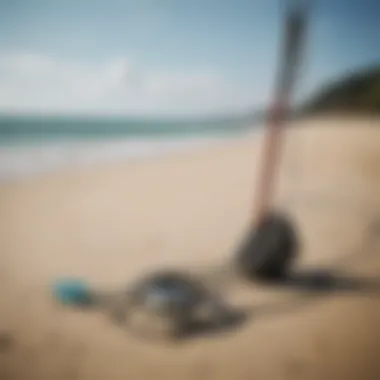

"Choosing the right kite anchor is as crucial as picking the right kite itself; it can make or break your day on the water."
Understanding these four types of kite anchors is essential for kiteboarders seeking to optimize their performance. Each anchor has its unique traits, advantages, and potential drawbacks that suit various conditions. Knowing when and how to apply them will lead to more successful and enjoyable outings on the water.
Benefits of Using Kite Anchors
Kite anchors play a crucial role in enhancing both safety and performance for kiteboarders. Their importance cannot be overstated, especially for anyone who spends considerable time on the water. Beyond merely holding the kite in place, kite anchors contribute to reducing potential accidents and optimizing the kites' performance under various wind conditions. Understanding the different benefits of using kite anchors helps riders make informed decisions that can significantly improve their overall kiteboarding experience.
Enhanced Safety
Safety is paramount in any sporting endeavor, and kiteboarding is no exception. Using appropriate kite anchors significantly reduces the risks involved with the sport, contributing to a safer outdoor experience.
Reducing Risks of Accidents
One primary aspect that kite anchors tackle is the prevention of accidents. Unsecured kites can easily drift away in changing winds, leading not just to lost equipment but potentially resulting in dangerous situations for the rider or nearby beachgoers. The key characteristic of kite anchors is their ability to secure the kite firmly to the ground. This functionality is especially beneficial when setting up a session on varied terrains or windy days.
Kite anchors equipped with sturdy designs can withstand strong gusts, ensuring that the kite remains in an optimal position preventing it from taking off unexpectedly. Thus, anchors like sand screws or traditional stake-style anchors have become increasingly popular amongst kiteboarders. The unique feature of these anchors is their robust construction, ensuring they hold firmly regardless of wind speed. This aspect offers peace of mind and allows the rider to focus fully on their session.
Stability During Wind Changes
Wind conditions are notoriously unpredictable, and one moment of instability can lead to chaos. When using kite anchors, the stability they provide during wind changes is invaluable. The key benefit here is maintaining the kite in a steady position, even when wind direction shifts suddenly. This reliability is especially advantageous for novice riders still mastering their control techniques.
A well-placed anchor prevents the kite from flipping or tangling in the lines. However, not all anchors are created equal; the effectiveness largely depends on the specific type and how well the anchor is suited to the environmental conditions. A solid anchor helps the rider remain calm, focusing on technique rather than worrying about their kite's erratic movements caused by sudden wind changes.
Improved Performance
Kiteboarding performance is not only about the rider's skill but also hinges on the equipment used. Kite anchors significantly enhance performance metrics, allowing riders to enjoy longer sessions with fewer interruptions.
Optimal Kite Positioning
One of the prime advantages of using kite anchors is achieving optimal kite positioning. When securely anchored, the kite can maintain a precise angle relative to the wind, maximizing lift and control. This positioning makes it easier for riders to execute tricks, transitions, and maintain steady lines.
The key characteristic of optimal positioning is its role in managing power. If the kite is held properly at the angle of attack, it can generate consistent power without overwhelming the rider, especially during sudden gusts. Moreover, a unique feature of kite anchors is their ability to adjust quickly based on immediate conditions. This adaptability allows riders to shift from cruising to performing with greater ease.
Sustained Flying Time
Another benefit kite anchors yield is sustained flying time. The ability to keep the kite steady allows riders to stay in the air longer and make the most of their sessions. Less worrying about kite control means more time focusing on enjoyment and practice.
The key aspect of sustained flying time is its direct impact on rider skill development. More time spent in the air allows for finer technique adjustments and a greater variety of maneuvers to be attempted.
While it is tempting to think that investing in high-tech kites or harnesses will deliver better results, the truth is that kite anchors often represent the unsung heroes of performance improvement. Their ability to maintain the kite's functionality through varied conditions can significantly elevate a rider's overall experience.
Kite anchors are not just accessories; they are essential allies for safety and performance on the water.
Selecting the Right Kite Anchor
Choosing the right kite anchor is crucial for both safety and performance in kiteboarding. A proper anchor keeps your kite stable in various conditions, which enhances your overall experience. As kiteboarding enthusiasts, understanding the specific factors that influence your choice ensures you can navigate different environments with confidence.
Factors to Consider
Wind Speed
Wind speed plays a significant role in kiteboarding. When selecting an anchor, it's important to understand how the wind affects your kite's position. If the wind speed is high, it can put tremendous strain on the anchor. A strong, durable anchor can be crucial, as it will ensure that your kite remains securely fastened to the ground or water surface.
Key characteristics of wind speed include its variability. On a day with shifting winds, your anchor must handle gusts that can suddenly increase. Choosing an anchor that is robust helps mitigate the risks associated with unexpected changes.
In terms of benefits, a reliable anchor not only prevents your kite from lifting away but also stabilizes it during sudden wind shifts. On the flip side, if you opt for an anchor that isn’t suited for high wind conditions, you might find your kite drifting off or tangling, leading to mishaps.
Water Conditions
Water conditions can vary widely and significantly impact your kiteboarding experience. Whether you’re dealing with choppy waters or still lagoons, the type of anchor you select must adapt to these variations.
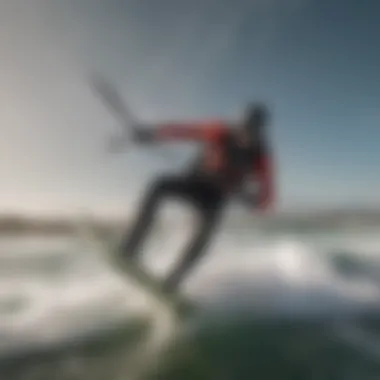

A key characteristic of water conditions is their depth and type. Shallower, sandy bottoms usually allow for sand anchors to perform effectively, while deeper waters may require more substantial options like screw-in anchors. The adaptability of your chosen anchor type helps clarify why it’s essential to assess the water condition.
The unique features of water conditions mean that failing to choose the right anchor can lead to failure during your session. For instance, a sand anchor might easily pull out in high tides, rendering it useless. Proper anchor choice adds a layer of security for your kite during any adventure on the water.
Terrain Type
Terrain type is another critical consideration when selecting a kite anchor. Whether you are on a hard, rocky ground or sandy beach, the anchor's compatibility with the terrain can make or break your experience.
The essential feature of terrain type lies in understanding its texture and stability. A rocky surface may necessitate a different approach than soft, yielding sand. Each terrain type has its own characteristics that affect how well an anchor can grip and hold.
Choosing an inappropriate anchor for a particular terrain can lead to frustrating outcomes, such as anchors pulling out or damaging your gear. It’s crucial to observe your surroundings – ensuring that the anchor can withstand the rigors of the environment is a foundational aspect of choosing wisely.
Adjusting to Conditions
Once you have considered the basic factors, understanding how to adjust your anchor selection to varying conditions is important for kiteboarders.
Adapting to Changing Weather
Weather certainly can switch up at a moment’s notice. When kiteboarding, being able to adapt to changing conditions is essential. A sudden shift in the weather can lead to unforeseen changes in wind and water, affecting anchor performance.
A key characteristic here is awareness. Just being conscious of the weather around you allows for timely updates to your anchor setup. Plus, a flexible approach means reassessing your anchor's effectiveness can lead to preventing potential mishaps. Failing to act on weather changes can result in lost equipment or even injuries.
Unique features of adapting to changing weather let kiteboarders make smart decisions. For instance, having multiple anchor types stored away allows you to switch to a more suitable option if conditions deteriorate, ensuring your safety and enhancing your enjoyment.
Site-Specific Considerations
Lastly, each site has specific needs that must be assessed. Site-specific considerations refer to the unique characteristics and challenges you might face in a particular kiteboarding location.
For example, a crowded beach might necessitate careful anchor placement to avoid interfering with others. The unique feature of each beach or lake can dictate how you choose your anchor. It’s not just about the water; it’s about the entire environment.
Considering the site beforehand can provide great benefits. A well-chosen anchor will not only keep your kite secure but also enhance your overall kiteboarding experience in that specific spot. However, careless choices can lead to problems such as entangled lines or clashing with other kiteboarders.
Understanding the complex interplay of wind speed, water conditions, and terrain type empowers kiteboarders to select the right anchor and adapt effectively, leading to safer and more enjoyable kiteboarding sessions.
Practical Application of Kite Anchors
Understanding how to practically apply kite anchors can significantly boost both safety and performance for kiteboarders out on the water. Kite anchors are not merely optional equipment; they serve vital roles in ensuring that your kite behaves as expected in various conditions. A well-set anchor allows the kite to remain stable during sudden gusts, enabling smoother rides. It's truly essential to grasp the specifics of setting and maintaining these anchors, as improper usage can lead to mishaps and an overall less satisfying kiteboarding experience.
Setting Up a Kite Anchor
Establishing a kite anchor correctly may appear straightforward, but it is far from a one-size-fits-all scenario. The first step is always to assess the site conditions like wind strength, water depth, and the nature of the terrain. Each of these factors can influence how you set up your anchor.
- Wind Direction: Always position your kite to face into the wind. This will aid in keeping the kite grounded and reduce any potential lift when on the water.
- Anchor Type: Based on the condition, choose the appropriate anchor. Sand anchors work great on beaches, while water anchors are optimal for lakes or river conditions.
- Secure the Line: Ensure the line attaching the kite to the anchor is taut but not overly strained. A loose line can lead to unwanted movements and instability.
When setting up, a common mistake is to overlook the anchor's positioning. If it’s too close to the waterline, or too far back, adjustments can become difficult while you're already kiteboarding. Always make sure it’s accessible yet securely planted to handle the force exerted by the kite during use.
Maintaining Anchor Integrity
The effectiveness of a kite anchor does not just stem from how it is initially set up. It is paramount to maintain its integrity over time to assure longevity and consistent performance. Regular checks can save you from potential troubles during your sessions.
- Inspect Regularly: Make it a habit to inspect your anchors for wear and tear before every kiteboarding outing. An anchor that has been compromised can lead to safety risks.
- Cleaning Equipment: After a day on the water, rinse your anchors with fresh water to remove salt or sand. This simple act can significantly prolong the lifespan of the materials and keep them functioning optimally.
- Check Connections: Ensure that all connections, such as carabiners and lines, are free from frays or damages. Trustworthy connections are key to avoiding unexpected breakages while out in the elements.
"A little diligence in maintaining your equipment goes a long way; it's better to be consistently cautious than to find yourself at the mercy of unforeseen challenges during your ride."
By being proactive in the setup and ongoing maintenance of your kite anchor, you're not just safeguarding your equipment but also enhancing your overall kiteboarding experience. This meticulous attention to detail can make the difference between an exhilarating ride and a frustrating day on the water. Moreover, it allows for better adaptability when facing varying conditions, thus letting you focus on what truly matters: enjoying your time under the sky.
Common Mistakes in Kite Anchoring
Kite anchoring is an element of kiteboarding that doesn’t always make headlines, yet it's crucial for a successful day out on the water. Mistakes in this area can lead to accidents, equipment damage, or simply a lackluster experience as the kite fails to perform optimally. Understanding common pitfalls can greatly enhance one’s safety and enjoyment. This section lays bare the typical missteps kiteboarders make and how to steer clear of them.


Overlooking Environmental Factors
Ignoring environmental conditions serves as the first strike against effective kite anchoring. Many kiteboarders might feel inclined to launch their kites without paying close attention to the wind patterns, water levels, or even nearby obstacles. It's easy to think a day with low winds will allow for a carefree session; however, wind can pick up swiftly, transforming a peaceful day into a chaotic experience.
For instance, kite enthusiasts should watch for potential wind shadow areas created by nearby hills or buildings. These can cause unpredictable gusts that catch riders off guard. Be alert to changes in wind direction—what feels like a gentle breeze can shift without a moment’s notice. Additionally, water conditions cannot be overlooked. For instance, shallow waters may not accommodate all types of anchors, which could prove problematic.
"Being aware of Mother Nature's mood is half the battle; don’t tempt fate by ignoring her signs."
Inadequate Anchor Selection
Choosing the right anchor may seem straightforward, but many kiteboarders either misinterpret the conditions or simply go with what they know from previous experiences. Not all anchors cater to every setting, and a novice might grab a lightweight sand anchor without considering if they are in a rock-strewn or muddy area. This choice could leave the kite vulnerable to strong currents or sudden wind changes.
A common error is relying on just one type of anchor that is familiar. For instance, someone might heavily depend on a low-cost water anchor while overlooking the need for a more robust solution on windy days. Each kiteboarding situation can be uniquely challenging; consequently, diversifying the anchor arsenal might help in adapting to unforeseen conditions.
Neglecting Equipment Care
In the hustle of preparing for a kiteboarding session, it’s easy to let equipment maintenance slip through the cracks. Anchors should be treated with the same respect as kites or boards. If anchors aren’t cleaned properly after use, sand, salt, or debris can hinder their effectiveness over time, making them less reliable. Similarly, inspecting the integrity of an anchor before use is not merely a suggestion; it's a necessity.
For example, a worn-out screw-in anchor may break under tension, leading to a disastrous outcome when it’s needed the most. Investment in good upkeep saves time and heartbreak down the line. Regular checks for rust on metal parts or replacement of frayed lines can mean the difference between a thrilling ride or a regrettable mishap.
In summary, being mindful about environmental factors, choosing anchors judiciously, and consistently caring for equipment can enhance performance, offering a safety net against potential issues. By fostering a deep awareness of these common mistakes, both inexperienced and seasoned kiteboarders can pave the way for a smooth and enjoyable kiteboarding experience.
The Future of Kite Anchors
As kiteboarding continues to evolve with new techniques and growing popularity, the future of kite anchors plays a pivotal role in how the sport develops. Innovations and improvements in kite anchor technology not only offer better performance but also enhance the safety of kiteboarders at various locations, whether on a breezy beach or a tranquil lake. Understanding trends and the trajectory of anchor design is vital for both enthusiasts and professionals alike. Emerging technologies can lead to breakthroughs that ultimately change how kiteboarders approach their sport.
Innovations in Anchor Design
Recent years have seen a shift towards more sophisticated kite anchor designs. Previous anchors were often limited in functionality and efficiency due to basic materials and construction methods. However, new models are being developed that take into account environmental factors and user safety. For example, some manufacturers are working on anchors that automatically adjust their grip based on shifting terrain or wind conditions. Imagine a system that senses when the kite shifts due to a gust and pivots accordingly to provide enhanced stability!
Another area to explore is the development of collapsible anchors that are easier to transport. Kiteboarders often travel to remote spots where luggage space can be at a premium. Lightweight, compact anchors that retain strength without extra bulk can offer a practical solution. Materials like titanium or high-density polymers are being tested to achieve a balance between weight and durability, crucial for a sport that thrives on mobility.
"Innovation isn't just about creating new products; it's about improving the experience for users and making the sport safer and more accessible."
Emerging Materials and Technologies
The materials used in constructing kite anchors are experiencing a significant transformation. Traditional models often relied on steel or aluminum, which can be cumbersome and subject to rust and corrosion when exposed to saltwater or sand. Modern alternatives such as carbon fiber or advanced composites are becoming more prevalent. These materials offer astounding strength-to-weight ratios, making them ideal for anchoring in a variety of conditions.
Moreover, developments in 3D printing technology can lead to even more customized solutions. Imagine being able to print a kite anchor designed precisely for your typical kiteboarding location. With the capability to create complex shapes that can maximize grip and stability, 3D printing offers potential unprecedented personalization for kiteboarders.
Finally, the integration of smart technologies is on the horizon. Sensors can be embedded within anchors to relay vital information about pressure and grip, allowing users to receive real-time data on their anchor performance. Such innovations can significantly enhance decision-making for kiteboarders, helping them to adapt quickly to changing conditions.
In summary, as the kiteboarding landscape continues to shift, the evolution of kite anchors must keep pace. Innovations in design and materials not only promise to improve the user experience but also emphasize safety and performance, vital for both seasoned riders and newcomers alike.
End and Best Practices
As we reach the end of our exploration into kite anchors, it's crucial to reinforce the significance of understanding their use and how best to implement them for a safe and enjoyable kiteboarding experience. The Conclusion and Best Practices segment serves as a final guide, emphasizing prudent choices and informed actions that can profoundly enhance both safety and performance on the water.
The proper usage of kite anchors not only stabilizes your kite amid changing conditions but also offers peace of mind while you enjoy your time on the water. When you're floating in the swell, it's easy to overlook the foundational importance of having your kite perfectly positioned, but with the right anchor and an understanding of how to set it effectively, you can significantly improve your kiteboarding outings. It’s about securing an enjoyable ride while minimizing risks associated with adverse environmental factors.
Recap of Key Points
To summarize the pivotal topics we’ve discussed:
- Types of Kite Anchors: Understanding the differences among traditional, screw-in, sand, and water anchors helps in choosing the right tool for specific conditions.
- Benefits: The enhanced safety and performance derived from using the correct kite anchor, including stability in varying winds and the ability to maintain optimal kite position, cannot be overstated.
- Selection Criteria: Factors such as wind speed, water conditions, and terrain are essential when selecting your anchor. Being aware of these can prevent many common mistakes.
- Practical Application: Setting up an anchor properly and ensuring its integrity is fundamental in achieving successful kiteboarding sessions.
- Future Considerations: Keeping an eye on innovations and emerging materials in kite anchor design will help in making informed choices that align with modern kiteboarding practices.
Further Resources for Kiteboarders
Online Forums
Online forums play a vital role in connecting kiteboarders from all walks of life. These platforms allow enthusiasts to share their experiences, seek advice, and discuss everything from gear to best practices. The primary characteristic of online forums is that they offer a community-driven space where advice comes not just from theory but from real-life application. Reddit, for example, hosts several kiteboarding groups where users can ask questions, share tips, and offer insights. Engaging in these forums is beneficial because it fosters a sense of belonging among kiteboarders while providing valuable information that can enhance one's understanding of kite anchoring techniques. However, be mindful of the varying levels of expertise among contributors—what works best for one might not be applicable for another.
Kiteboarding Schools
Kiteboarding schools stand as another invaluable resource for both novice and experienced kiteboarders. These institutions provide structured learning environments where students can receive hands-on experience with kite anchoring and safe practices. One of the notable characteristics of kiteboarding schools is that they often employ certified instructors who have a wealth of knowledge about equipment, weather conditions, and safety protocols. Attending courses or workshops can greatly benefit participants by offering personalized attention and feedback, thereby improving their skills considerably. The unique feature is the practical application of techniques in a controlled setting, which can vary by school location and conditions, potentially posing both advantages and disadvantages for those looking to refine their skills.
In light of these resources, kiteboarders are encouraged to tap into the wealth of knowledge available through online communities and instructional venues. By doing so, they can elevate their kiteboarding practices, making them much safer and more enjoyable.





